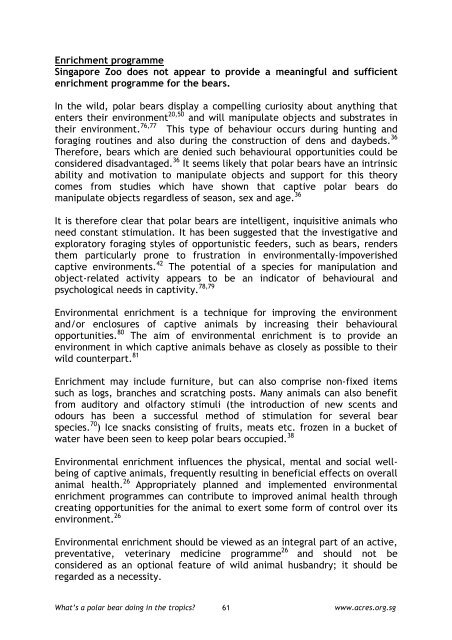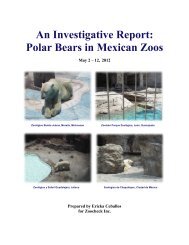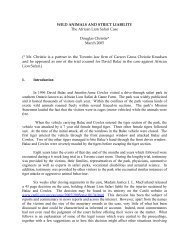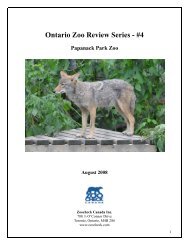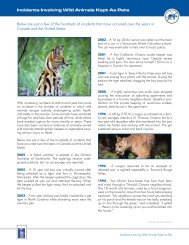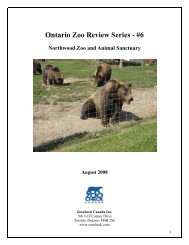What's a Polar Bear Doing in the Tropics? - Animal Concerns ...
What's a Polar Bear Doing in the Tropics? - Animal Concerns ...
What's a Polar Bear Doing in the Tropics? - Animal Concerns ...
Create successful ePaper yourself
Turn your PDF publications into a flip-book with our unique Google optimized e-Paper software.
Enrichment programmeS<strong>in</strong>gapore Zoo does not appear to provide a mean<strong>in</strong>gful and sufficientenrichment programme for <strong>the</strong> bears.In <strong>the</strong> wild, polar bears display a compell<strong>in</strong>g curiosity about anyth<strong>in</strong>g thatenters <strong>the</strong>ir environment 20,50 and will manipulate objects and substrates <strong>in</strong><strong>the</strong>ir environment. 76,77 This type of behaviour occurs dur<strong>in</strong>g hunt<strong>in</strong>g andforag<strong>in</strong>g rout<strong>in</strong>es and also dur<strong>in</strong>g <strong>the</strong> construction of dens and daybeds. 36Therefore, bears which are denied such behavioural opportunities could beconsidered disadvantaged. 36 It seems likely that polar bears have an <strong>in</strong>tr<strong>in</strong>sicability and motivation to manipulate objects and support for this <strong>the</strong>orycomes from studies which have shown that captive polar bears domanipulate objects regardless of season, sex and age. 36It is <strong>the</strong>refore clear that polar bears are <strong>in</strong>telligent, <strong>in</strong>quisitive animals whoneed constant stimulation. It has been suggested that <strong>the</strong> <strong>in</strong>vestigative andexploratory forag<strong>in</strong>g styles of opportunistic feeders, such as bears, renders<strong>the</strong>m particularly prone to frustration <strong>in</strong> environmentally-impoverishedcaptive environments. 42 The potential of a species for manipulation andobject-related activity appears to be an <strong>in</strong>dicator of behavioural andpsychological needs <strong>in</strong> captivity. 78,79Environmental enrichment is a technique for improv<strong>in</strong>g <strong>the</strong> environmentand/or enclosures of captive animals by <strong>in</strong>creas<strong>in</strong>g <strong>the</strong>ir behaviouralopportunities. 80 The aim of environmental enrichment is to provide anenvironment <strong>in</strong> which captive animals behave as closely as possible to <strong>the</strong>irwild counterpart. 81Enrichment may <strong>in</strong>clude furniture, but can also comprise non-fixed itemssuch as logs, branches and scratch<strong>in</strong>g posts. Many animals can also benefitfrom auditory and olfactory stimuli (<strong>the</strong> <strong>in</strong>troduction of new scents andodours has been a successful method of stimulation for several bearspecies. 70 ) Ice snacks consist<strong>in</strong>g of fruits, meats etc. frozen <strong>in</strong> a bucket ofwater have been seen to keep polar bears occupied. 38Environmental enrichment <strong>in</strong>fluences <strong>the</strong> physical, mental and social wellbe<strong>in</strong>gof captive animals, frequently result<strong>in</strong>g <strong>in</strong> beneficial effects on overallanimal health. 26 Appropriately planned and implemented environmentalenrichment programmes can contribute to improved animal health throughcreat<strong>in</strong>g opportunities for <strong>the</strong> animal to exert some form of control over itsenvironment. 26Environmental enrichment should be viewed as an <strong>in</strong>tegral part of an active,preventative, veter<strong>in</strong>ary medic<strong>in</strong>e programme 26 and should not beconsidered as an optional feature of wild animal husbandry; it should beregarded as a necessity.What’s a polar bear do<strong>in</strong>g <strong>in</strong> <strong>the</strong> tropics?61www.acres.org.sg


